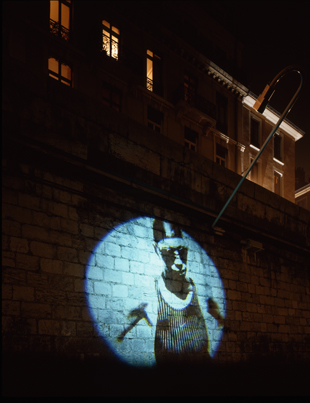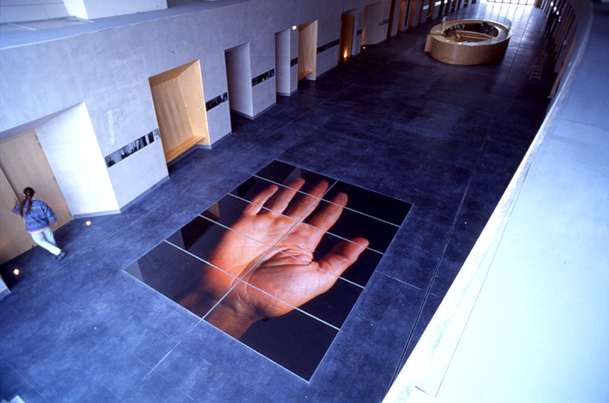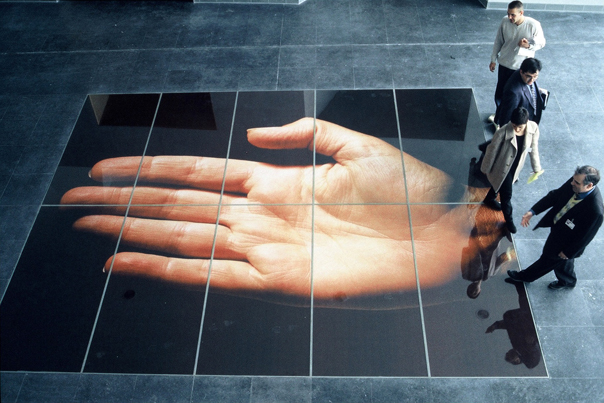Feb 19, 2012 | Laboratoire en
The point for Maryvonne Arnaud was to meet a new audience, as common as the street’s one, but following the thread of a discreet process where one would be given time to discover each detail, each uncertainty or hesitation of the matter.
Taking place in a flat located in a large public housing unit, this exhibition looks like a question. A flat without inhabitants, only occupied by daily objects, which are fixed, covered with sheets, either immaculate or printed with photographs. These images also overrun the floor and the walls; they become wallpapers and carpets.
Bulky images in a flat cluttered up with bulky objects – as one’s furniture that doesn’t fit a new apartment after moving, either because the presence of the previous inhabitants is still too strong or like uncertain objects, from here or there, both present and absent, material or symbolical, that one would have carefully protected and veiled.
We can settle in this apartment, touch the furniture, open the fridge and hear then other sounds than the neighbour’s ones: the noises of Algiers, the distant sound of the markets, the conversations in the apartments of Belcourt or Bab El Oued, where Arabic and French languages inextricably mix.







Feb 19, 2012 | Laboratoire en
“retorts” is a lasting luminous installation, springing from the traditional plays of lights and shadows in Arabian architecture and enriched with the imaginary of contemporary artists working all over the world.It takes place right in the heart of Algiers : the famous Tunnel des Facultés.
Walking or driving into the tunnel, the passer-by will enter an immaterial work of art, taking in its whole perception. This town-scale installation is grafted onto the public lighting network of Algiers so as to be switched on automatically and stage a new work of art every hou
Designed by artists whose formal and symbolic research is about light and shadow, these light etchings have crossed the planet to carve here, in the womb of Algiers, a multifarious imagery, evocative of both the particular and the universal.
The guest artists are Rachid Koraïchi, Daniel Laskarin, Farid Belkahia, William Kentridge, Gonçalo Ivo, Ene Kull, Ammar Bouras, Liz Rideal, Pinaree Sanpitak, Jyoti Bhatt, Richard Prince, Abderrazak Sahli, Meelis Salujärv, Gülsun Karamustapha, Ester Grinspum, Manisha Parekh, Denis Martinez, Rekha Rodwittiya, Sumi Wakiro, Lu Shengzhong, Nicola Durvasula, Adel El Siwi, Adlane Djeffal, Jacqueline Fabien.







A few tricks to tame the shadow
« retorts» is dedicated to the man-in-the-street, the tireless walker in the Tunnel des Facultés. I have spent so many hours watching him cross the Tunnel since my first visit in January 2002, guided in Algiers by Rachid Karachi! In turns easy-going, careless or exhausted, sometimes walking alone but most of the time in compact clusters swaying across together, it is never the same man nor the same woman who dives into the Tunnel and crosses the tube, immersed in the inner heart of Algiers, to re-emerge in the sun a few minutes later. Maybe there is nothing unusual in the renewed experience, yet it brings one on intimate terms with the daily underground town, its ancient foundations and moods, the womb of dreams, shadows and lights.
Lights, precisely! Now the passer-by will enter light, being totally immersed in it. Each crossing will be a unique experience to him as space will wrap him anew. Each carving of light will have crossed the planet to be inscribed here like a scratch or an etching, sometimes like a tattoo or a scar. For behind each work stands a sort of dazzling proliferation of the world, the dizzy diversity of life, there is an artist alive somewhere in the world, who from Cairo to Bangkok offers Algiers his own vision of light, his innermost recipe to tame shadow.For this first opus, here are the cocktails of shadows and lights from Ammar Bouras, then the dazzling epics of Rachid Koraichi, next the genii from the Egyptian Adel el Siwi, the cut out figures of Gülsun Karamustapha, and come from the Canadian Far West, Isle of Vancouver, the silhouettes of Daniel Laskarin.
Other Opus will follow, testifying to other practices in the world, other frail subtle tricks transmitted from Johannesburg or from Baroda.
Those impalpable images, whose life lasts as long as they persist on the retina, will all the same deeply implant in the heart of Algiers a daily complicity with foreign lights.
Philippe Mouillon
Feb 19, 2012 | Laboratoire en
Ground scars, threads between two dizziness or dust web between two « crossings » creates an original dialogue between the conquest of the mountain landscape by walking, and the progression of the words, memory and ideas.
Four writers, Pascal Amel, Jacques Darras, Jacques Lacarrière and Hervé Planquois together with the photographer Maryvonne Arnaud, associate their looks and confront their perceptions of the same territory, the Étançons valley at the bottom of the south face of the Meije
« crossings» is a true new experiment in the artistic logic of Laboratoire, usually rooted in urban contexts, since it is here a natural site, particularly imposing, where there’s almost no human-beings
Both the images and the words that compose this installation running along a path create a contemporary imaginary of the high mountains.








ORIGINAL TEXT BY JACQUES LACARRIÈRE
Cicatrices du sol, fils entre deux vertiges ou toiles de poussière entre deux horizons ?
Tracés par les milliers de pas des cheminants, ils sont voies d’aventure et réseaux de patience, miroirs et sceaux de nos efforts. Et sur chacun de leurs versants on peut lire partout l’ubac de nos fatigues.
Cheminer, ici, c’est ascendre. Côtoyer les nuages et surprendre le ciel en son intimité. Devenir voyeur d’azur et d’infini.
Au bout de ce chemin des cimes, je lis cette inscription : pèlerin des nuages, ici commence l’oratoire des vents.
Pérégriner : le plus beau verbe pour dire jadis le sens et le but du voyage. Pérégrin : le plus beau mot d’antan pour dire l’oblat et le pratiquant des chemins. Pèlerin : son double d’aujourd’hui, son frère en cimes et en vertiges.
Au terme de la montée, soudain et comme inattendu : le ciel. Pour lui, les monts s’écartent, les vallées s’incurvent, l’horizon se déploie. Et quel plaisir de sentir et savoir que là-haut, tout à l’heure, le ciel vous donnera audience. À condition que tout soit clair. En lui et surtout en vous.
Grandiose. Mot risqué, insolent mais qui veut dire au fond : oser ce qui est grand. Ici, la montagne a osé. À nous aussi, d’oser être grand, être haut. De nous mettre, le temps d’un essor, à l’école des aigles. D’apprendre comme eux à glatir dans l’azur. Glatir, la seule façon ici de parler aux montagnes.
Pierres amoncelées. Pierres éparpillées. La Terre elle-même jadis a dû choisir : rassembler ses enfants ou bien les disperser aux quatre vents. Enfants des quatre vents, les pierres des montagnes.
Sous la houle figée des versants, chaque pierre est balise immobile, écume pétrifiée de la mémoire des glaces.
Ayons toujours en vue l’humilité des pierres. Lourdes ou légères, denses ou friables, elles demeurent indifférentes aux joies, insensibles aux remords, étrangères à tout ressentiment. C’est pour cela qu’elles font partout cortège aux pentes comme aux gouffres, aux chemins comme aux cimes, aux neiges comme aux vents. Elles sont parures des solitudes et parements des altitudes. Demeurer où le sort les a jetées ou rejetées et résister au temps est leur unique but. Ayons toujours en vue la patience des pierres.
À la croisée des vents, il convient d’édifier pierre à pierre son havre et sa maison de certitude.
Cairns : bouées de pierre disposées tout au long des chemins d’éclairs et d’orages pour orienter et pour aider les naufragés de l’altitude.
Une à une, sur le socle nu des saisons, ces pierres déposées, distillées par le ciel, comme les stalactites de l’azur.
Je suis seuil et je suis chemin.
Je suis pierre qui dit l’horizon.
Je suis l’enclos des pas nomades.
Je suis paume où se lisent les lignes de l’ailleurs.
Trop loin. Trop lourd. Trop immobile. Roc ancré dans le sol, le sol inéluctable après les lendemains d’ivresse immaculée. Dépôt ou résidu d’un vertige glaciaire ? Débris ou déchet porté, emporté, transporté dans l’anonymat des moraines, et déporté dans les enclos du vent ?
Depuis des millions d’années, je gis. Orphelin du froid.
Lentes reptations des glaces qui avancent, oppressent puis se retirent. Et qui m’ont laissé là, témoin de leurs élans, de leurs désirs inaboutis.
Témoin aussi des griffes et des serres du vent : ces gerçures, cassures, vergetures, ces lézardes sur la peau fossile du temps.
Et maintenant, devenu nuit, livré aux ecchymoses des saisons, aux fantaisies du vent, aux érosions du temps, qui me délivrera du châtiment d’être immobile ? Qui me restituera la douceur erratique ?
Jacques Lacarrière
Feb 19, 2012 | Laboratoire en
At nightfall, the quays along the Isère River, in the historical heart of Grenoble, open to the world. Fragile and impalpable images, simply made up of shadows and lights, drift along the stream, like a vast frieze underlining the town.
These images have crossed the world to get here. They have been specially created – on a canvas designed by Philippe Mouillon – by artists living around the world, in Egypt or Canada, in Brazil or Japan
Once in Grenoble, the original images are integrated in an experimental technologic prototype designed on Gaz Electricité de Grenoble’s initiative in collaboration with Philips-lighting. They are blown-up on the retaining wall of the quays by a discreet network of optical fibres.
This installation allows the town to live a new and dreamlike life at night. They forgotten quays, exhausted by the intensive traffic, become a place of walk and harmony.






Drawing by Lu Sheng Zhong

Drawing by Rachid Koraichi

Drawing by Rekha Rodwittiya

TEXT BY JACQUES LACARRIÈRE
What is the use of a river? What is the use of a river? The question is hardly ever asked. As for the sky and the earth its existence goes without saying. For a long time rivers have been viewed as a source of drinkable water, a free waterway moving downstream from town to town to reach the sea, as a reservoir of fish one may catch and water fowls one may hunt. Such are the folk tales, the human history of the river at the time of horse-drawn barges and of punts and craft. But rivers have other uses, more for games and less for work, to swim and dive and probe its intimate depths, to sunbathe on their small sand islands, to dream on their banks, imagine their estuaries, the seas into which they flow and the distant Polynesias.
But Heraclites says : “The river is always a Here and a There.” Somewhere else, but also a language, the speech of riverbanks, friendly waters, mud islets, streams, deltas. This language puzzled me, this grammar of swirls and streams either slow or madly swift, waters running from different places.If streams lose their names as soon as they meet a river this doesn’t mean they also lose their distinctive water, I mean the very nature, the density, the singular personality of their water. This is the reason why every river has a history, almost an epic, a long run tale, an aquatic story. When it springs forth it is often but a trickle without a name, without a fate. But as soon as it asserts itself, carries on, digs its way into the incline of the slopes and is framed by the scenery, then it takes on a name, its own name, it can say “I”. But fast enough, while it flows down, others will join him, mingle their waters with his, and the river “I” will lose his identity and say “We” instead. And when this “We” reaches his end and is united with the sea, merges into the vastness of the ocean, he will then lose both his “I” and his “We” and become “All”. Surely there is, in the depths of the Atlantic, rivulets of water still tasting of the Loire, but soon absorbed, drowned into the cosmic taste of the sea, this taste of universal salt.
A river is made up of a thousand different sources and his riches and his reason for being and flowing is the interblending of its waters.
Every river is half breed and interbred. And I no longer want to be told about Roots! I well know the trees. I have grown and matured in their branches, but trees can tell us nothing other than their native soil. They know nothing of the whole world. The whole world can only be taught by rivers on this earth and by migratory birds in the sky.
Rivers are migrating waters, messengers of the universal.
Jacques Lacarrière
Feb 19, 2012 | Laboratoire en
Maryvonne Arnaud installs a man’s and a woman’s hand, palm out-stretched, etched in the floor of the new law courts of the Melun city built by Françoise-Hélène Jourda
By their great size, these images make it possible to enter the memories of one’s life, accumulated in the lines, in the intimate details of the skin or the tracks of previous wounds. But it’s an illusionary opportunity, since our exploration remains incomplete.
These offered palms, seemingly open as an interface between « I » and « the other », maintain the filiation with the primitive hands of the art at the dawn of humanity.When walking on these photographs set in the floor, one should remember this arrogant and disenchanted text by Jean-Paul Sartre, to conclude his biography:
« At the end, what’s left?
A whole man
Composed of all men
And as good as all of them
And no better than any. »








































